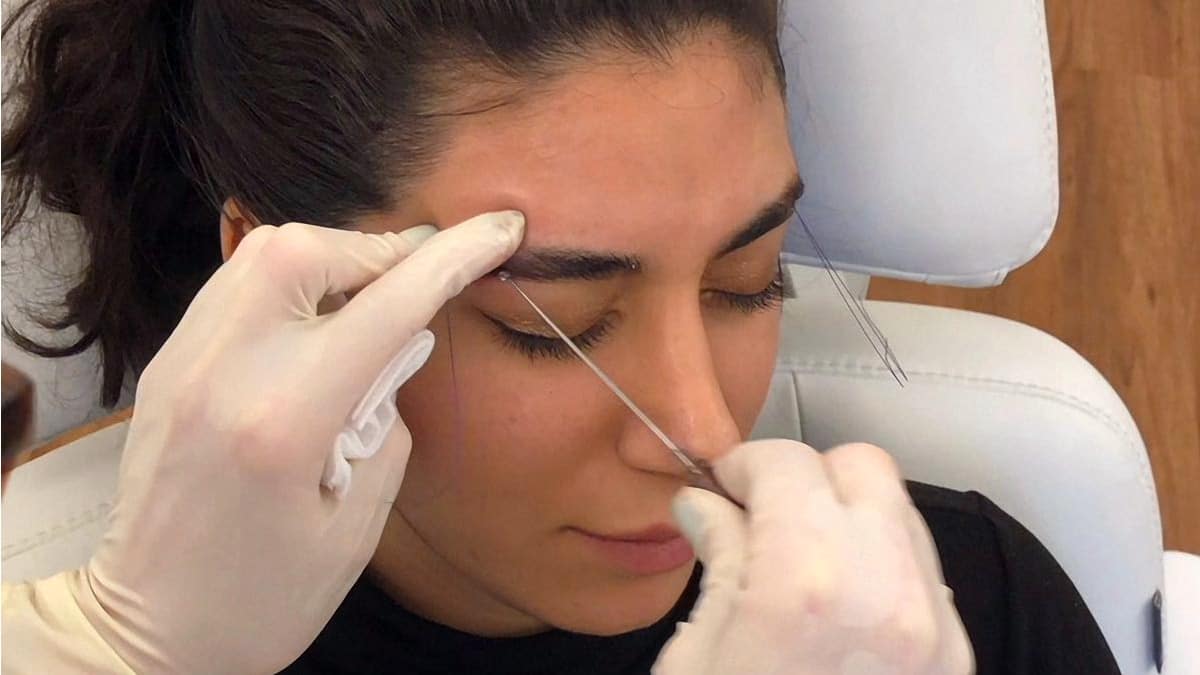Thread Lift Munich – Skin Tightening Without Surgery
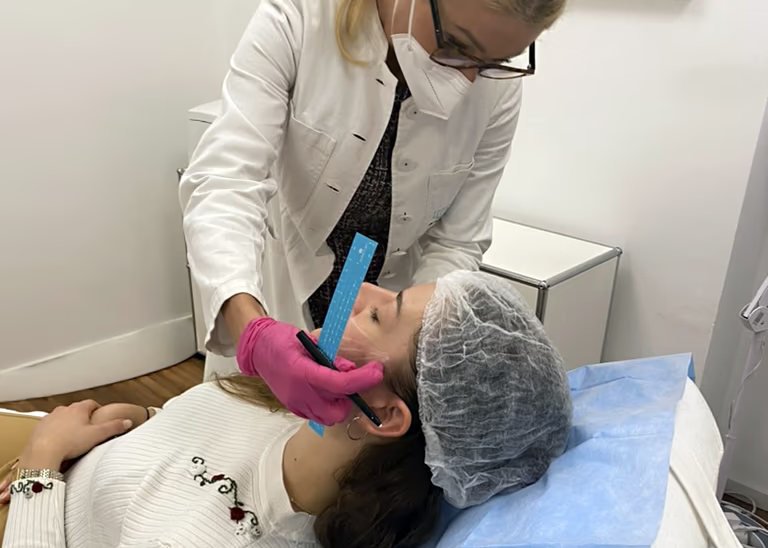
Thread Lift in Munich at a Glance
- Treatment Goal: Tighten sagging skin without surgery
- Treatment Areas: Cheeks, jawline, neck, eyebrows
- Mechanism of Action: Insertion of absorbable threads for mechanical lifting and stimulation of new collagen production
- Results: Immediate lifting effect with progressive skin tightening over several months
- Duration of Results: Approximately 12–18 months, depending on skin condition and thread type
- Treatment Time: About 30–60 minutes
- Anesthesia: Local infiltration anesthesia
- Social Downtime: Usually 1–2 days
- Side Effects: Mild swelling, bruising, or tightness for a few days
- Cost: Starting at approximately €300 for mono threads and €620 for Silhouette Soft (guide price, billed according to the German Medical Fee Schedule – GOÄ).
Table of Contents:
- What Is a Thread Lift?
- How Thread Lifts Work – Benefits and Longevity
- Who Is a Good Candidate for a Thread Lift?
- Which Types of Threads Are Used?
- Treatment Procedure
- Risks and Possible Side Effects
- Thread Lift Cost in Munich
- Why Choose Dr. Eva Maria Strobl for a Thread Lift in Munich?
- FAQ – Thread Lift Munich
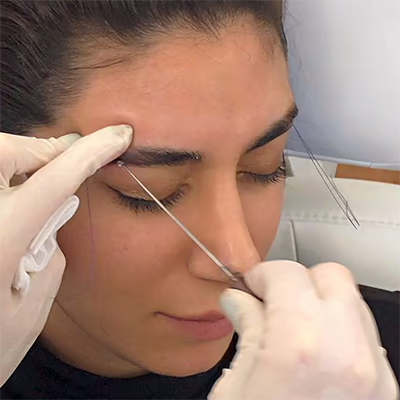
What Is a Thread Lift?
A thread lift is a minimally invasive procedure for skin tightening without surgery. Fine, absorbable threads are placed under the skin to gently lift sagging areas. At the same time, they stimulate collagen production, improving skin firmness over time.
Unlike a surgical facelift, a thread lift leaves no scars and requires minimal downtime. The results look natural and preserve your facial expressions.
Thread Lift in Munich – Gentle Lift Without Surgery
At my practice in Munich, thread lifts are performed using advanced materials and precise techniques. The treatment is ideal for early signs of skin laxity, such as sagging cheeks, jawline definition, or for lifting the brows. The lifting effect is visible immediately and continues to improve over the following weeks as the skin regenerates naturally.
Thread Lift for Nasolabial Folds
Thread lifting is especially effective for nasolabial folds, gently lifting the midface and smoothing the crease—without adding volume.
The cost of a thread lift depends on the treatment area and the number of threads used. In my Munich practice, all prices are discussed transparently during your consultation and tailored to your individual needs.
How Thread Lifts Work – Benefits and Longevity
Immediate and Long-Term Results
A thread lift combines two effects: an instant tightening from the inserted threads and long-term skin firming through the stimulation of natural collagen production. This not only improves facial contours but also enhances skin quality over several months. The degree of the immediate effect depends on the type of thread used.
Longevity of Results
Depending on the thread type, skin condition, and technique, results last about 12 to 18 months. While the threads gradually dissolve, the newly formed collagen remains, maintaining a firmer appearance.
Benefits of a Thread Lift
- Natural lifting without surgery or scars
- Minimal downtime, usually social-ready after 1–2 days
- Improved skin texture through regeneration and collagen renewal
- Can be combined with Botox, hyaluronic acid, or PRP treatments
- Versatile for areas such as cheeks, jawline, or brows
A thread lift offers an effective way to refine facial contours and tighten the skin—without surgery.
Who Is a Good Candidate for a Thread Lift?
A thread lift is ideal for individuals seeking gentle skin tightening without surgery. It provides an effective solution for early skin laxity and reduced elasticity—when topical treatments or non-invasive methods are no longer sufficient.
Ideal Treatment Areas
The thread lift achieves especially good results in the following areas:
- Cheeks and jawline for improved contour definition
- Eyebrows for a more open look or specific styles such as the fox-eye effect
- Forehead, either as an alternative or complement to Botox or hyaluronic acid treatments
- Nasolabial folds to soften deeper lines
- Neck and lower jawline to tighten sagging skin
Younger patients are increasingly choosing this method to prevent early signs of aging and maintain well-defined facial contours.en.
When a Thread Lift Is Less Suitable
In cases of significant skin laxity or pronounced tissue sagging, a surgical facelift is usually the more effective option. A thread lift would be costly and unlikely to achieve satisfactory results, even with stronger lifting threads. In such cases, I provide honest and transparent guidance on the best treatment approach.
Which Types of Threads Are Used?
Several types of threads are available for a thread lift, differing in structure, tension, and effect. Depending on the treatment goal, they can be used individually or in combination to achieve skin tightening, lifting, or volume restoration.
Mono and Screw Threads: For Subtle Tightening and Skin Improvement
Mono and Screw Threads are smooth, absorbable PDO threads that do not create mechanical lift but stimulate collagen production to strengthen skin structure. Screw threads have a coiled shape that adds a mild volumizing effect, providing internal support to the skin. Both types focus on biological regeneration and smoothing rather than lifting.
- Treatment Areas: Cheeks, neck, jawline, nasolabial folds, décolleté, scalp
- Tension Strength: Low to moderate
- Price: From approximately €300, depending on area and number of threads
Since mono threads exert little traction and mainly activate collagen synthesis, they are typically used in higher numbers—often 20 or more per treatment area. For scalp treatments, 40 to 50 threads may be inserted to promote even skin regeneration and improved tissue circulation..
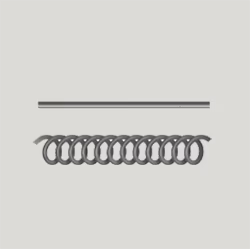
COG and Cone Threads: For a Visible Lifting Effect
COG and Cone Threads feature tiny barbs or cones that anchor into the tissue, creating a noticeable mechanical lifting effect. They visibly elevate sagging facial areas while also stimulating new collagen formation.
- Treatment Areas: Cheeks, jawline, eyebrows, neck
- Tension Strength: High, with a clear lifting effect
- Price: From approximately €400, depending on area, thread type, and quantity
COG and Cone threads achieve subtle lifting in facial areas with minimal muscle activity. For optimal and longer-lasting results, it can be beneficial to relax the muscles with Botox beforehand, helping the lift remain more stable and even.n.
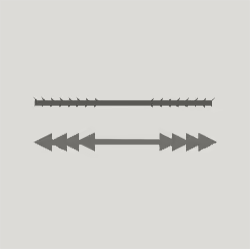
Silhouette Soft Threads: For Strong Lifting and Long-Lasting Results
Silhouette Soft Threads are made of polylactic acid and feature bidirectional cones that anchor securely within the tissue. They create an immediate lifting effect while stimulating skin regeneration over several months. The threads fully dissolve after 18–24 months.
- Treatment Areas: Midface, cheeks, jawline, neck
- Tension Strength: Very high, close to a surgical facelift
- Price: From approximately €620, depending on area, thread type, and quantity
Silhouette Soft threads can achieve more extensive lifting without surgery, as multiple areas can be elevated simultaneously. Their placement requires advanced precision and experience, and costs are higher due to both the material and the increased procedural complexity compared to standard PDO or COG threads.
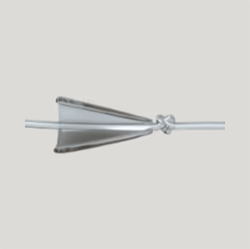
Treatment Procedure
A thread lift—especially with COG or Silhouette Soft threads—is considerably more complex than an injection of Botox or hyaluronic acid. It sits at the upper limit of what can still be called minimally invasive. Therefore, patients should take time to carefully weigh the benefits, possible side effects, and costs.
For this reason, thread lifts in my Munich practice are not bookable online; only a consultation appointment can be scheduled. During this medical consultation, I perform a detailed examination, provide personalized advice, and explain the procedure thoroughly. The actual treatment is scheduled only after a reflection period of two to three weeks.
Typical Procedure:
- Preparation: Cleansing and disinfection of the skin, marking of entry points if necessary, and local anesthesia using an injectable anesthetic.
- Insertion of Threads: Gentle placement of the threads with fine cannulas along the planned tension vectors.
- Adjustment and Check: Threads are lightly tightened to achieve the desired lifting effect, followed by sterile coverage.
- Aftercare: Cooling, avoiding strong facial movements and physical exertion for several days; follow-up visit after about two weeks.
Aftercare is particularly important following a thread lift. During the first few days, facial strain should be avoided—this includes dental visits or cosmetic treatments. Patients should also refrain from vigorous chewing and adjust meals accordingly. Tightness or pulling sensations in the treated area are common initially, so it’s advisable to schedule the treatment when no major social events are planned immediately afterward.
Risks and Possible Side Effects
Despite precise technique and sterile conditions, thread lifts—like all minimally invasive procedures—may cause temporary or, rarely, more serious side effects. Typical risks include:
- Mild swelling or redness at the treatment site
- Small bruises at entry or exit points
- Noticeable tightness or pulling sensation, especially during the first few days
- Temporary asymmetry if swelling occurs unevenly
- Nodules or irregularities if threads or cones shift slightly
- Thread ends that may protrude through the skin, usually temporary and easily corrected
- Tenderness when chewing or making strong facial expressions in the early phase
- Allergic reactions, rare and usually material-related
- Infection at insertion points, especially if aftercare is insufficient
- Vascular injury or embolism, rare, with increased risk in highly vascularized regions—medical experience is crucial here
Overall, a thread lift is considered a safe procedure when performed by an experienced physician under proper conditions and when aftercare instructions are followed carefully.
Thread Lift Cost in Munich
The following thread lift prices are guideline values based on my clinical experience. Actual costs are always calculated according to the German Medical Fee Schedule (GOÄ) and may vary—sometimes significantly—from these reference amounts.
As shown in the price overview, treatments using Silhouette Soft threads can, depending on complexity, amount to several thousand euros. Depending on the desired effect and treatment extent, patients should carefully consider whether a thread lift is truly a cost-effective long-term option or whether a surgical facelift might offer a more lasting and suitable solution.
Scroll
| Treatment | Price (indicative, incl. VAT) |
|---|---|
| Mono 2 × 10-15 threads | 280-395€ |
| Screw 2 × 2-4 threads | 280-420€ |
| COG 2 × 2-4 threads | 400-800€ |
| Cone 2 × 2-3 threads | 520-800€ |
| SILHOUETTE SOFT 2 x 1 threads | 620-800€ |
| SILHOUETTE SOFT 2 × 3 threads | 1.800-2.200€ |
| SILHOUETTE SOFT 2× 5 threads | 2.900-3.200€ |
| SILHOUETTE SOFT 2 × 6 threads | 3.700-4.000€ |
| Consultation | 75€ |
FAQ – Thread Lift in Munich
Depending on the thread type and individual skin condition, results typically last 12 to 18 months. As the threads gradually dissolve, the lifting effect from newly stimulated collagen production usually remains visible for much longer.
The procedure is performed under local anesthesia and is generally well tolerated. Afterward, a feeling of tightness or pressure may occur and can be more noticeable during the first few days. Over-the-counter pain relief such as ibuprofen usually provides relief. Any discomfort typically subsides completely within about one week.
Yes. A thread lift is often combined with hyaluronic acid fillers, PRP treatments, or Botox to enhance and harmonize the overall result.
A thread lift is not performed during pregnancy or breastfeeding at my Munich practice. The procedure is considered contraindicated during this time, as there are no sufficient studies confirming the safety of the materials and local anesthetics used.

About the Author
Dr. med. univ. Eva Maria Strobl is the owner of LIPS and SKIN Aesthetic Medicine practice in Munich. She is a trained specialist in general medicine (MedUni Vienna) and has over 10 years of specialization in non-surgical aesthetic procedures. Dr. Strobl is a member of the German Society for Aesthetic Botulinum Therapy e.V. (DGBT), the German Society of Anti-Aging Medicine e.V. (GSAAM) and of Network Global Health. She publishes regularly on her blog and on DocCheck.
